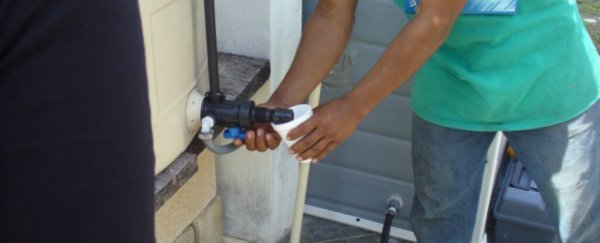Up until recently, soda was cheaper than bottled water in La Mancalona, a village in the jungle of Mexico's Yucatan peninsula. As with many remote communities, clean drinking water was almost a luxury for the local subsistence farmers.
Now, thanks to a simple system engineered by researchers from MIT in the US, the locals can purify water on their own by harnessing another resource available to them in ample amounts - the energy of the sun.
"This is a whole new paradigm for providing clean water for people in need," said MIT professor Steven Dubowsky, who started this project back in 2012.
The water purification system consists of two solar panels that generate electricity used to power a set of water pumps, which then push water through a filter of semi-porous membranes. These membranes help to filter out dissolved solids and biological contamination. The technology is known as photovoltaic-powered reverse osmosis, or PVRO.
As with many locations around the world, groundwater in La Mancalona is rather salty. Using this new, affordable method, the residents of the tiny village are able to purify both rainwater and the brackish water found in their local well, producing around 1,000 litres a day – that's enough to supply a village of around 450 people, all from a device the size of a small shed.
What's wonderful about the project is that MIT researchers didn't just swoop in and provide the locals with a ready-made solution. Instead, the team trained members of the community to operate and maintain the system once it had been installed.
As team leader Huda Elasaad explained to MIT News, farmers in remote villages are very handy, so the main challenge was actually the language barrier for handing instructions down from English through Spanish to the local Yucatan dialect.
"The entire time, you're just hoping nothing gets lost in translation," said Elasaad. "The nice thing about technology is, it kind of speaks for itself. You can show with very easy diagrams and hands-on training, right next to them, that turning a valve doesn't have to be said in so many words — you can just show them."
Maintenance of the technology has proven to be a breeze – the local technicians are able to change out the ultraviolet lamps and water filters that test water quality, and have no trouble replacing batteries and sourcing spare parts as required.
The purification system has also become a great community-driven business. For nearly two years now the residents of La Mancalona have been buying 20-litre bottles of purified water for a price they've chosen themselves - five pesos per bottle. Usually water would sell for around 25 pesos and is only available from the nearest town, around an hour away.
There's a committee managing the profit, some of which is set aside for the maintenance of the system, while the rest goes back to the community.
"They're also trying to develop a business plan focused on selling clean water to tourists who come to the local Mayan ruins," said Elasaad.
This solar-powered technology is built in a way that makes it easy to adapt to the local environment, and can employ a range of purification methods, including electrodialysis and nanofiltration. Given the success of this Yucatan field trial, MIT researchers are now working on finding ways for distributing these solar-powered systems to other communities in need.

